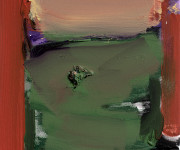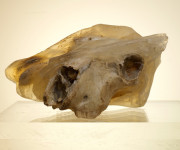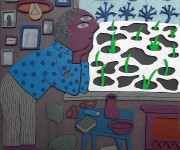From 7 April, Vilnius gallery Meno Niša will open the exhibition The Book of Sand by Jānis Šneiders, one of the most outstanding Latvian painters of the younger generation and winner of several awards. The environment created by the artist will provide the viewer with stairs to climb, corridors to wander, and doors to open.
A book, as a motif and a physical space, has become the central theme of Jānis Šneiders’ latest work and his 9th solo exhibition, drawing inspiration from Argentinian writer Jorge Luis Borges’ short story collection El libro de arena (1975). The title of the exhibition, like Borges’ short story, uses the allegory of the sand to refer to a state where there is no beginning nor end. “It was as though the pages sprouted from within the book,” Borges writes, unable to find either the first or the last page.
The exhibition The Book of Sand continues the successful cooperation with the Riga Contemporary Art Gallery LOOK!, where the exhibition of the artist Jurgis Tarabilda, who is presented by gallery Meno Niša, opened last year. “One of the important goals of Meno Niša is international cooperation, especially between Baltic galleries and artists. We have hosted a number of exhibitions of artists from neighbouring countries – in February we hosted an exhibition by Andris Vītoliņš, and now we are delighted to present the work of Jānis Šneiders, a Latvian with a distinctive style,” said Diana Stomienė, the director of Meno Niša, adding that this exhibition is part of the gallery’s 20th birthday celebration exhibition program this year.
As the well-known Latvian curator and writer Elīna Sproģe writes in the annotation of Jānis Šneiders’ exhibition, “moving from the one-dimensional ‘line’ to the three-dimensional ‘volume’, a book appears to reside between dimensions. Everything starts with a blank page. Then letters and words transform pages onto spaces. They dictate directions and paragraphs; they open up and enclose subjects. Šneiders uses this structure to play with the myriad ways to experience physical space.
By creating ‘fictitious’ pages of The Book of Sand, the artist anticipates the works to become artefacts of various infinities. The exhibition displays different interpretations of a sheet of paper. Separate pieces mirror each other, are ruptured, and they communicate through a negative space in between them. The architectural structure of Meno Niša seemingly continues in the imaginative space of an artwork. Slight glitches, duplicates, repetitions, and offsets start to appear, that had not been characteristic of Jānis Šneiders’ exceptionally accurate renders of reality. Those are new gestures that suggest that he might be trying to make the viewer trip over,” says Elīna Sproģe.
Jānis Šneiders (b. 1995) graduated from the Art Academy of Latvia, faculty of painting, and is currently working on an MA in Audio-Visual Media Art. He has held 8 personal exhibitions and more than 30 group exhibitions, both in Latvia and abroad. For his solo exhibition Vieta (gallery LOOK!) he was nominated for the most prestigious Latvian prize in fine arts – Purvitis Prize 2021. His works can be found in private collections in Latvia, Estonia, Germany, Belgium, and Luxemburg.
Some of his works have also been acquired by the Latvian National Museum of Art and Secco Pontanova foundation art collections. In 2019, he received the Nordic & Baltic Young Artist Award in painting, and in 2020, in Berlin, he received the prestigious Secco Pontanova foundation Claus Micheletz – Preis 2020 award.
Jānis Šneiders’ painting exhibition The Book of Sand at the gallery Meno Niša will be open from 7 to 29 April. The gallery is sponsored by Vilnius City Municipality. The exhibition is organized by the galleries Meno Niša and LOOK!.
Exhibition annotation by Elīna Sproģe
“Lines consist of an infinite number of points; planes an infinite number of lines; volumes an infinite number of planes, hypervolumes an infinite number of volumes…”
Jorge Luis Borges
“A book as a motive and a physical space has become the main subject matter of Jānis Šneider’s latest work. The allegory of sand, used in the title of the exhibition as well as the collection of short stories by Argentinian writer Jorge Luis Borges (El libro de arena, first published in 1975), refers to a state of having no beginning nor end. Borges portrays himself captivated and frightened by the state of being lost within the covers of this mysterious book that he has been presented with. ‘It was as though the pages sprouted from within the book’, he writes, unable to search for the very first or last page.
Also moving from the one-dimensional ‘line’ to three-dimensional ‘volume’, a book appears to reside between dimensions. Everything starts with a blank page. Then letters and words transform pages onto spaces. They dictate directions and paragraphs; they open up and enclose subjects. Šneiders uses this structure to play with the myriad ways to experience physical space. By creating ‘fictitious’ pages of ‘The Book of Sand’ the artist anticipates the works to become artefacts of various infinities. The exhibition displays different interpretations of a sheet of paper. Separate pieces mirror each other, are ruptured and they communicate through a negative space in between them. The architectural structure of Meno Niša, seemingly continues in the imaginative space of an artwork. Slight glitches, duplicates, repetitions and offsets start to appear, that have not been characteristic to Jānis Šneiders exceptionally accurate renders of reality. Those are new gestures, that suggest that he might be trying to make the viewer trip over. Georges Perec wrote in the ‘Species of Spaces’ (Spèces d’espaces, first published in 1974) that ‘when nothing arrests our gaze, it carries a very long way. But if it meets with nothing, it sees nothing, it sees only what it meets.’ The environment, created by Šneiders gives us stairs to climb, corridors to wander and doors to open. It brings us beyond the vanishing point where time is not trapped like sand in an hourglass.”












